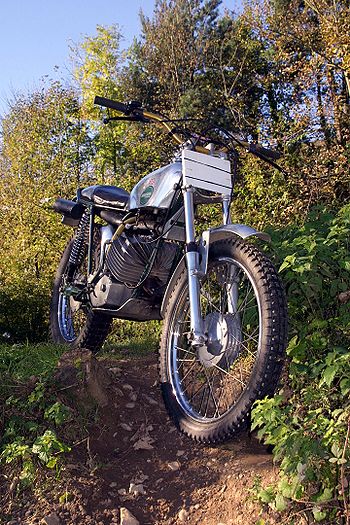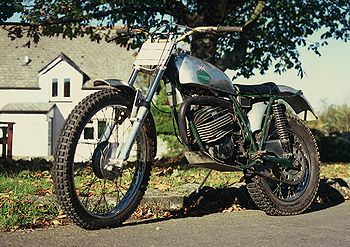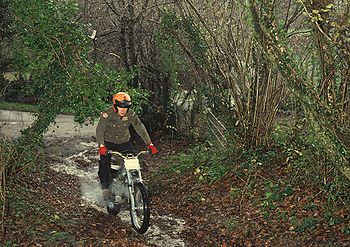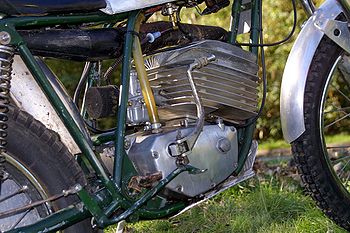Greeves Pathfinder M59
Leading link forks, cast alloy beam frame and the ubiquitous Villiers engine sums up the image of the archetypical Greeves trials machine: a bike on which many a budding mud – plugger made their first tentative wobbles. For me it was a twelve year old Scottish in an open to centre trial high on the Mendips on a bitterly cold day in November 1972. My Fanciful youthful hopes of emulating the prowess of Don Smith & co quickly brought to earth with a crash - in fact many – on a day which is now memorable for numerous fives, one solitary clean and finally retirement (read relief) when the footrest snapped: clearly something more competitive was needed but what were the options. The Spanish invasion was in full flow so something from the ‘big three’ was the obvious - or perhaps sensible - choice. However fighting a rearguard action for the Brit’s were the works Greeves trio of Mick Wilkinson, Scott Ellis and Derek Adsett on the recently introduced Pathfinder: a new -and very different - machine to the old style Anglian that Billy Wilkinson had ridden to victory in the 1969 Scottish six days.
Gone were not only the Villiers engine but also the distinctive alloy beam frame, the leading link forks and even the traditional Moorland Blue paintwork. In their place a 170cc six speed two stroke from Puch, Ceriani telescopic forks and a Reynolds 531 tubular frame in a color called ‘hunting green’. There was denying it certainly looked the business and optimism was high but despite the works riders initial successes the Pathfinder would remain in production for just two short years.
The factory records are rather hazy as to exactly how many were produced but history would record it would be the last trials iron to roll off the Thundersley production lines: although its passing was not mourned by some Greeves aficionados who regarded it as not a ‘proper’ Greeves. Proper or not it’s certainly an integral –and now rare - part of the little Essex manufacturer’s chequered history and certainly one worth reflecting on. Before we fire our test bike up and head for the first section perhaps a quick recap as to how this hastily arranged ‘shotgun marriage’ between Greeves and Puch came about.
Barely a handful of years earlier there had been – in addition to Greeves - a plethora of small British manufacturers like Cotton, Dot, Francis Barnett, DMW and Sprite all manufacturing competitive two stroke trialer’s. Sadly by the mid sixties they suffered a double blow from which they never recovered.
In May 1965 the first production Bultaco appeared and if this wasn’t bad enough, barely twelve months later Manganese Bronze announced that engines would no longer be made available for rival manufacturers. In the short term Metal Profiles took over the production rights of the Villiers 32/37A which during 1967 and 1968 gave some breathing space but clearly this was only a stop gap measure. The harsh options were either to throw in the towel or, like Greeves, Cotton and Dot source a new supplier of engines. Cotton and Dot turned to Italy and a 170cc Minarelli engine while Greeves went to Austria and a similar capacity engine from Puch. - Misguidedly I bought a Cotton Cavalier before quickly moving on to Ossa! The prototype Pathfinder was debuted by factory boss Bert Greeves at the Greybeards trial in August 1969 although by the time it reached production its one piece –and very noisy – exhaust system, Puch roadster brake hubs, high level front mudguard and fibre glass fuel tank had all been changed. The production launch was planned for the end of 1969 and in a letter dated 11th December 1969 marketing director Derry Preston Cobb contacted the motorcycle press with a list of amendments and updates on the previous specification: advertising brochures were prepared and distributed with triumphal headlines announcing.
‘The 175cc Pathfinder, the trials model to challenge the world’
The reality was that Greeves would be quickly swept aside by the burgeoning Spanish torrent although at the time the brochure was up-beat and very optimistic about their chances. ‘The combined engineering talents of Greeves – Great Britain – and Steyr-Daimler-Puch – Austria bring you the Pathfinder, the trials model to challenge the world’. The 175cc Puch engine is a result of the pooling of knowledge from these two most enthusiastic factories intent on providing you, the trials rider, with a really potent unit with low maintenance costs. The six speed gearbox allows selection of just the ratio for the ‘nadgery’ section or for a quick blast on the road – while frame wise you benefit from all the Greeves know how of quality, performance and reliability. We are therefore proud to present the new 175cc Pathfinder. It is undoubtedly a new conception in trials, offering the lightness and handling of an ultra lightweight with the power and performance of a two fifty. It is certain that there will be a great future for the Pathfinder, both as a conventional trials bike, and for riding over all types of rough country’.
Heady claims if true – and already flawed in as much the engine capacity was 169cc – but the Puch motor needed development and it would be nearly another twelve months before the bike actually arrived in the showrooms.
As was quickly discovered the combination of short stroke (62x56mm) engine, high 11:1 compression ratio and a pair of light flywheels gave all the wrong sort of power characteristics needed from a trials unit.
There was no doubt that in the hands of a skilled factory rider the bike had potential and Billy Wilkinson scored their first international win at Graz in Austria and along with team mate Derek Adsett finished well up in the tough Lambrorell trial in Belgium.
However for the typical clubman the best power was all produced too far up the rev range and when put under load at relatively low rpm it was liable to suddenly cut out. This problem only partially overcome by a pair of heavily weighted flywheels, a compression ratio lowered to 10.6:1 and a modification to the exhaust system which spread the power farther down the range. All of this development work of course took both time and money and it would be September 1970 before the much vaunted newcomer - priced £259 in ‘kit form’ - made its long awaited and overdue debut. Motorcycle journalists had been eager to sample Thundersley’s new offspring and in their edition dated 23rd September Motor Cycle led with the headline ‘The birth of the Pathfinder, Greeves’ answer to the Spanish invasion’. Staffer Peter Fraser put it through its paces reaping praise on both its power and handling: commenting ‘the new 175cc Pathfinder looks like giving the opposition something to worry about in the feet up game this winter’. Rather apologetically Greeves themselves also ran a quarter page advert for the new bike which read ‘Sorry we’ve kept you waiting ….. But it’s all been worthwhile’.
The sad fact was Greeves had been away for the trials scene for two long years: two years in which the opposition had made substantial inroads and they (Greeves) had simply missed the boat. The anticipated volume sales –much needed to boost the company’s dwindling resources – never materialised and production of the Austro – British marriage came to a halt late in 1972.
They were bleak but not totally barren years as in 1970 the Pathfinder had its moment of Glory in the Welsh two day trial (enduro). The Welsh was the traditional selection and proving ground for those selected to ride in the September ISDT however on the eve of the event British teamster Mick Wilkinson discovered that his Cheney Triumph was not available. He therefore elected to ride his Pathfinder and despite a puncture and a prang Wilkinson out-pointed the first day leader AJS motocross star Andy Roberton over the second 290 mile stage for overall victory.
As Puch themselves had already proven in the ISDT their engine was not lacking in stamina or reliability and the peaky power delivery was perfectly suited for an enduro machine. In fact such a Pathfinder with lights and duel seat – an ideal tool for the growing and potentially lucrative American off road market - was produced during 1971: unfortunately by then the high output levels of the mid sixties was down to a trickle and only a handful were actually made.
Our test bike doesn’t wear a number plate although access to the old factory records - via the GRA archives – reveals the 62A engine was manufactured in 1971. Any subsequent history or provenance is totally unknown between the times it rolled off the production lines to the day thirty five years later it turned up at my house.
Just in case you’re confused please let me explain. I have an unashamed soft spot for the little bikes from Thundersley and thanks to marque enthusiasts - Colin Sparrow, Tim Griffin and Dave Bradley - I’ve been lucky enough to ride some of their rarest and most unusual machines. Sadly my efforts in trying to source a Pathfinder to test had drawn a blank: it seemed like they’d all disappeared. That was until I saw one advertised on E bay and - with impulse getting the better of me - a click of the mouse later I was in the auction. In conventional ‘auctioneers speak’ bidding would probably be described as ‘quiet’: so much so that when an e mail turned up informing me I had ‘won’ the Greeves I’d almost forgotten about it. Buying something on the strength of a couple of photos and an owners description is all a bit alien to me but with my wallet lightened to the effect of £650 I was the proud owner of a ‘bike to challenge the world’.
Friends - who had never seen a Pathfinder let alone owned or ridden one - suddenly became authorities on the idiosyncrasies of the little Puch engine with dire warnings about its abundance of shims, circlips and distance pieces: which along with its flywheel clutch makes it a nightmare to work on. Possibly something to rue and reflect on in the future but it only took a quick mix of some 25:1 petroil, copious flooding of the 26mm Bing carb and one swing of the kickstart to bring the two stroke into life. The displacement may only be a modest 170cc but the finning on the cylinder barrel and head is massive and with a 10 ½” span there was understandably quite a bit of fin resonance. The cast-iron lined barrel is a conventional four port pattern with the exhaust port bridged while the exhaust system itself is held in the port by a spring. Sparks are via a Bosch flywheel magneto which supplies its power to a contact-less transistorised system and although a willing starter from cold I discovered the coil was breaking down when under load: this soon sorted with one of unknown origin supplied by the ever helpful Trott’s motorcycles in Totnes. The same source also cleverly fabricated a repair to some damaged alloy on the rear Grimeca brake hub which was hindering brake lever travel.
Resplendent in its bright 1 ½ gallon light alloy petrol tank, polished Ceriani tele’s – 1972 models changed to MP 600’s – and conventional twin loop Reynolds 531 frame the Pathfinder looks very purposeful so what’s it like to ride ‘on the rough’?
My local practice sections are largely made up of wet, rocky climbs and on these the little Greeves was in its element: on paper a 40:1 bottom gear ratio might seem very low but as I quickly discovered it’s ideally suited to the engines power characteristics. Certainly when the same sections were tackled in second and third it soon showed up the engines lack of bottom end and it took a stout prod on the gear lever to bring it singing back into the power band. Somewhat unusually a decompressor is fitted into the head and although this could be advantageous on steep descents in practice it was found to foul with mud and ‘mine’ has now been blanked off. The exhaust note was fairly subdued although I understand that in their comprehensive list of ‘go better goodies’ – designed by Reg May and marketed by Comerfords – there was a modified system which did away with the expansion pipe and Greeves ‘gas bottle’ end. Not only was this quieter - with built in glass fibre noise absorption – but the bike suddenly needed higher gearing to cope with the new lower end power curve.
Another Comerford mod’ was a footrest lowering kit but I found the overall set up of riding position, handling and braking to be absolutely spot on. All in all I returned from the test feeling pleasantly surprised with my E bay ‘impulse buy’ although whether it has the ability to turn a ‘Wessex centre wobbler’ into a ‘world beater’ we shall have to wait and see?
Andy Westlake - December 5th 2006
Greeves Pathfinder M59 Specification[edit | edit source]
| Part | Spec |
|---|---|
| Engine | Puch single cylinder two |
| Capacity | 169cc |
| Bore | 62mm |
| Stroke | 56mm |
| Compression ratio | 11.5:1 |
| Power output | 20bhp @ 8000rpm |
| Lubrication | 25.1 petroil |
| Gears | 6 speed |
| Carb | 27mm Bing |
| Ignition | Bosch flywheel magneto fully transistorised |
| Frame | Duplex Reynolds 531 tubing |
| Front suspension | Ceriani telescopic |
| Rear suspension | Swinging arm twin shocks |
| Front tire | 2.75 x 21" |
| Rear tire | 4.00 x 18" |
| Fuel capacity | 1.5 gallons |
| Weight | 190lbs |
| Ground clearance | 11" |
| Wheelbase | 51" BSA Victor |
| Price new | £259 kit form |



